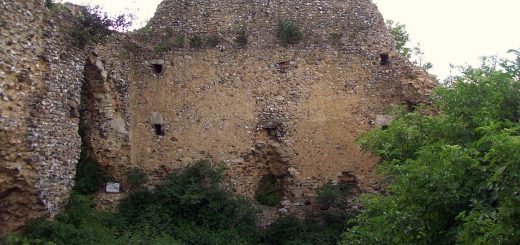Hornby Park Mistress and Margaret Brackin
John Harland and T. T. Wilkinson give the following account of a haunting tradition in Lancashire Folk-lore (1867). ‘The following story is told and believed by some persons in Hornby. The Park Mistress may be supposed to be the ghost of Lady Harrington, who committed murder three hundred years ago. Margaret Brackin was born in 1745, and died in 1795. The dialect is that of the locality:—
“In days that oud folks tell on still, Meg Brackin went up Windy Bank; Shou lated kinlin’ on the hill, Till owr t’ Lake Mountains t’ sun it sank.
Nat lang at efter t’ sun was set, And shou hed fill’d her brat wi’ sticks, Shou sid aside at t’ Park wood yett, A woman stan’in mang the wicks.
T’ leaves on t’ trees, they owm’ered t’ land, And fadin’ was the summer light, When Marget sid that woman stand Donn’d like a ghoost o’ oor i’ white.
Marget was fear’d, but spak and ex’d, ‘Hey Missis! let me gang wi’ ye, I hope as that ye’ll nut be vext, But it is gitten dark and dree.’
T’ Park Mistress e’en shin’d o’ wi’ leet; Shou whyatly cam te Marget’s side; T’ gerss didn’t bend underneath her feet; Shou seem’d in t’ air te float and glide.
As soon’s shou cam whare Marget stood, Shou gript a tight houd on her hand; Shou led her first intul t’ Park wood, Then back and forret o’ owr t’ land.
They kept na road, they kept na path, They went thro’ brackins, scrogs, and briar, Marget shou soon was out of breath, But t’ lady didn’t seem te tire.
They baath com down te Wenning’s brink,And Marget’s throat was dry wi’ dread, But shou dursn’t ex te stop and drink,Saa forret still that woman led.
Owr shillar and rough staans they trod, Intu t’ Wenning, then out fra t’ stream; Surlie their walkin’ wasn’t snod, T’ way they travell’d was naan saa weam.
Marget lous’d t’ strings of her brat,And trail’d it gerss and bushes through, Till deg’d and damp and wet it gat; Then suck’d it out for t’ cooling dew.
Fra Weaver’s Ayr they went up t’ wood, Now gaain’ straight and then aslant, They niver stopt, they niver stood, But raac’d up t’ brow saa rough and brant.
Marget could niver gradely say Where nesht wi’ t’ ghoost shou went that neet; On Windy Bank, when it was day,They fun’ her liggin, spent wi’ freet.
Marget hed been stout and throddy, But t’ walk she tuk that summer neet, Left lile fatness on her body;At efter shou was thin and leet.”
The following extract from ‘A History of the County of Lancaster: Volume 8 (1914) by William Farrer & J. Brownbill (editors) shows when the Harrington family were associated with Hornby. ‘Sir Robert de Nevill of Hornby the younger and Margaret his wife occur in a settlement of the castle of Hornby and manor of Melling in 1363. He probably succeeded soon afterwards. In 1376 he prosecuted several persons for cutting his trees and underwood at Arkholme and Hornby, and in 1394 as lord of the manor claimed certain franchises there. He died in 1413 seised of the castle, manor and lordship of Hornby held in chief of the king as duke by the service of one knight’s fee. His son Thomas had died in or before 1387, leaving a daughter Margaret, who at her grandfather’s death was thirty years of age. She was the wife of Thomas Beaufort Earl of Dorset and Duke of Exeter, one of the legitimated sons of John of Gaunt. The duke survived his wife and died in 1426, but had in 1424 demised his interest in the manor and castle of Hornby and other estates to Sir William Harrington and others.
There was no surviving issue of the marriage and the inheritance was divided between Sir Robert’s daughters Margaret and Joan and their issue. The latter had married Sir John Langton and her son received the manor of Hutton Longvilers. Margaret married the above-named Sir William Harrington of Farleton, who fought at Agincourt, and continued to serve in the French wars. In 1431 Sir William and Margaret his wife were found to hold Hornby by one knight’s fee. Sir William died 22 February 1439–40, and Dame Margaret in or before 1451, when she was found to have held the castle and manor of Hornby, with its appurtenances, of the king as Duke of Lancaster by knight’s service.
The son and heir Sir Thomas Harrington had been seneschal of the Hornby Court in 1427, and occurs later in various pleadings. He was in France in 1430, and served as knight of the shire between 1432 and 1449. He was a Yorkist, and it was alleged that in November 1458 he took part in a party council at Middleham and afterwards made a settlement of his estates. He fell at Wakefield in 1460, fighting for the Duke of York. His eldest son Sir John was killed at the same time and the Hornby inheritance fell to Sir John’s two daughters Elizabeth and Anne. Dower from the castle of Hornby and various manors was in 1478 ordered to be given to Elizabeth widow of Sir Thomas.
Of the co-heirs Elizabeth married John Stanley and then Richard Beaumont, and left three daughters —Joan wife of Sir Thomas Halsall, Anne wife of John Swift and Margaret wife of Thomas Grimshaw; while Anne married Sir Edward Stanley, a son of the first Earl of Derby. He had Hornby as his portion of the Harrington lordships, but, as there was doubt as to the right owing to various forfeitures for treason, Henry VII made a special grant to him of Hornby, Farleton and appurtenant manors and lands; the whole was to be held of the king in chief by the service of one knight’s fee.





Recent Comments